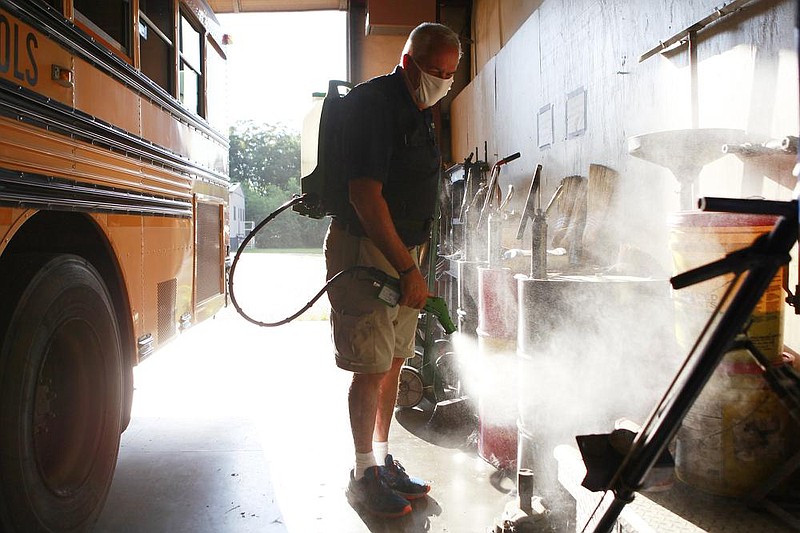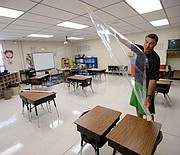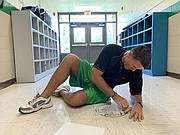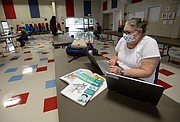America's education system has never had to deal with anything like the covid-19 pandemic. Its impact is unprecedented.
Educators and researchers expect that most students lost ground academically in the spring when schools closed to in-person instruction, exacerbating the learning loss that occurs during a typical summer. And, with no assessment testing for Arkansas students this spring, teachers don't know where the students stand starting a new school year.
[Video not showing up above? Click here to watch » https://www.youtube.com/watch?v=_c1PS9h4_Tg]
Virtual learning, the port in the pandemic storm, has mixed reviews at best on its effectiveness at a time when more families than ever are expected to embrace it.
The shift from in-person to virtual education was easy for some students, but a challenge for others, especially those who lack internet access at home and kids who already had disadvantages -- including disabilities, living in poverty and English language barriers.
Arkansas leaders fear that the pandemic will widen the state's achievement gap, eroding decades of progress toward providing every student an adequate and equitable education.
Gov. Asa Hutchinson in mid-March directed all public schools, which serve more than 470,000 students, closed to on-site instruction as part of an effort to slow the spread of the coronavirus.
Schools are set to reopen next week for the 2020-21 school year -- a year in which masks, social distancing and temperature checks will be as important as reading, writing and arithmetic.
Most students will be face to face with their teachers, though a significant number will remain at home and get their education online; they will be expected to learn as much and at the same pace as their peers sitting in classrooms.
The Arkansas Division of Elementary and Secondary Education directed school districts to prepare an education program for the coming school year that relies on face-to-face and online instruction with the flexibility to blend them and to pivot from one to the other.
The pandemic has opened new territory for all educators, said Assistant Superintendent Megan Slocum of the Fayetteville School District.
"If you go back to your first year of teaching, that's exactly what this year is going to be like for everybody," she said.
LEARNING SLIDE
There is widespread concern about how prepared students are academically for the new school year because of the disruption caused by covid-19.
When schools shifted from in-person to virtual education, the amount of time students spent on instructional activities generally plummeted, according to a national survey of public education's response to covid-19 by the American Institutes for Research.
On average, school districts expected high school students to spend 3.87 hours per day on instructional activities during the spring. The lower the grade level, the less time was expected. At the kindergarten-through-second-grade level, the average was only 2.2 hours per day, according to the organization's findings.
These time expectations are lower than the daily instructional hours required by states. Arkansas normally requires six hours of instructional time per school day.
The same survey showed that, for some districts, distance learning primarily focused on reviewing content taught earlier in the year rather than learning new content. Johnny Key, Arkansas' secretary of education, told parents this spring not to try to teach new concepts but to focus on reviewing known content.
That was especially true in high-poverty and rural districts. For example, for kindergarten-through-fifth grades, 29% of high-poverty districts focused on reviewing past lessons, whereas only 8% of low-poverty districts did the same, according to the survey.
Research about the summer-slide phenomenon, in which students return from summer vacation knowing less than they did before the break, has been mixed, but studies have shown that students can lose anywhere from two weeks to three months of learning over the summer.
Using what they know about extended school breaks, researchers at Northwest Evaluation Association, Brown University and the University of Virginia projected what could come from a "covid-19 slide." Their paper, published in May, was titled, "Projecting the potential impacts of covid-19 school closures on academic achievement."
The researchers acknowledged difficulty making those projections because of variations in the experiences students and teachers had with virtual learning from March through the end of last school year.
They estimated that students likely will return to school with 63%-68% of the learning gains in reading relative to a typical school year and with 37%-50% of the learning gains in math.
"However, we estimate that losing ground during the covid-19 school closures would not be universal, with the top third of students potentially making gains in reading," their paper states. "Thus, in preparing for fall 2020, educators will likely need to consider ways to support students who are academically behind and further differentiate instruction."
Sarah McKenzie, executive director of the University of Arkansas, Fayetteville's Office for Education Policy, said her biggest concern heading into the school year is that students weren't able to take end-of-year assessments last spring, meaning schools lack good information on where students are in their learning.
McKenzie also believes the lack of test data will force educators to focus on more individualized instruction that meets the needs of each student, rather than trying to plow ahead with the same one-size-fits-all curriculum.
Tracey-Ann Nelson, executive director of the Arkansas Education Association, believes the learning loss will be significant for about 70% of students.
"We have kids who have never gone on to their computer to participate in school since March," said Nelson, who leads the state's largest teacher organization.
It's not all bad news, according to Laveta Wills-Hale, coordinator of the Arkansas Out of School Network, which promotes expansion of after-school and summer programs for kids.
Summer learning programs are stepping up like never before with the support and encouragement of medical providers, business leaders, government officials and others, Wills-Hale wrote in a recent news release.
She offered examples such as Tendaji Community Development Corp. in Little Rock, which is offering families virtual tutoring appointments for core subjects. Tendaji also started a virtual art camp last month, in which students picked up boxes of materials and created at-home art projects by following online instructions, she wrote.
VIRTUAL QUALITY
Distance learning for elementary and secondary students has risen in popularity for years. The pandemic forced schools nationwide to embrace it, ready or not.
Although the state is mandating that all schools be open for in-person instruction, many Arkansas families have signed their children up to continue with virtual school this fall.
Chris Goering, a University of Arkansas professor of English education, finds that interesting.
"Roll the clock back six or seven months, almost all of these same people would have been dead set against virtual learning. And I think they would have been right to question it before and may also be right to support it now," Goering said.
Goering said national studies on virtual-school student achievement come back with "atrocious" results.
Researchers at the National Education Policy Center, housed at the University of Colorado, released a report last year that cited overall poor performance by the nation's full-time virtual and blended-learning schools.
They recommended that policymakers "slow or stop the growth" in the number of these schools and the size of their enrollments until the reasons for their poor performance have been identified and addressed.
They also noted sparse research describing the experience of students enrolled in virtual or blended learning schools, and suggested that state and federal policymakers create long-term programs to support independent research on and evaluation of virtual schooling.
"Many argue that online curriculum can be tailored to individual students more effectively than curriculum in traditional classrooms, giving it the potential to promote greater student achievement than can be realized in traditional brick-and-mortar schools. These claims are not supported by the research evidence," according to the report.
Victoria Groves-Scott, the dean of the University of Central Arkansas' College of Education, said the college is the only one in the state that offers teachers an endorsement to teach kindergarten-through-12th-grade online.
"We're really invested" in virtual education, she said. "And, done well, it can be amazing."
Students can work in groups, have conversations, see presentations and take virtual field trips, Groves-Scott said. She acknowledged limitations: virtual education can be a challenge, especially for young children who may have a harder time paying attention and for children with disabilities.
She sees great potential for virtual education, but fears its reputation could be further harmed if too many schools do a poor job with it this school year.
"But we also have this huge opportunity in front of us where we can revolutionize the way we're teaching," Groves-Scott said.
TECHNOLOGY TALK
The sudden shift to online learning spotlighted technology and the extent to which students have access to it.
Arkansas ranks 41st among the states in access to high-speed broadband, according to the website BroadbandNow.com.
In a state survey answered by 247 of the 256 Arkansas' public school districts and charter schools, 198 reported at least 10% of their students don't have home internet access.
Springdale, the state's largest district, was one of 39 districts that reported more than 40% of their students lack home internet access. Little Rock reported that 30%-40% of its students don't have home internet access.
[Gallery not loading above? Click here for more photos » arkansasonline.com/816schools/]
Those students without home internet access used community Wi-Fi hot spots, Wi-Fi access devices or flash drives loaded with lessons to get their work done. Some students relied on printouts of work, which they picked up and dropped off at their schools.
Hutchinson announced last month that the state would spend $10 million in federal aid to buy about 20,000 Wi-Fi access devices for families with school-age children, so those kids can have home internet access. The devices will be provided to families based on need and come with 24 months of unlimited data, Hutchinson said.
Key said the devices represent a temporary fix for the state's broadband challenges.
The Little Rock School District is getting 500 Wi-Fi access devices through the state's program and is buying 2,500 more, Superintendent Michael Poore said.
"We're working with our community to provide other places where kids can go to get a good Wi-Fi connection, whether that's at schools or community buildings," Poore said. "We're working with our city and our Chamber of Commerce to accomplish this."
ACCESSING EQUITY
The pandemic and resulting closure of schools magnified the inequities in children's lives outside school, said Paul Reville, a professor at the Harvard University Graduate School of Education and former education secretary for Massachusetts.
"We've had a digital divide all along, but it didn't matter as long as people were in school," he said.
There also are divides among children in terms of access to food and health care. Schools help students with those kinds of basic needs. The pandemic caused people to realize just how many services the schools provide children beyond education, Reville said.
Jay Barth, a former chairman of the state Board of Education, was tagged by the mayor of Little Rock as the city's chief education officer. His task is to make schools in disadvantaged areas into community hubs offering a variety of services to students and their families. Those could include after-school and summer programs, social and mental health workers, and meal programs.
"If you look at the issues where covid's effects are most pronounced, it highlights the inequities that are already there," Barth said.
"The ability to opt out of the classroom is going to vary a great deal. People talk about digital equity. That has three components: connectivity, literacy and the device gap. Of those three, the device gap is the easiest to close," he said, noting the $1 billion in federal funding the state received under the Coronavirus Aid, Relief, and Economic Security Act.
But having a reliable internet connection and parents who are computer literate and able to help cannot be bought and equally distributed, he said.
"The group that is going to get hurt the most by this are the kids who are already on the lower end of the achievement gap: the ones on free and reduced lunch, which tend to be African-American and Latinx."
The state Supreme Court ruled in 2002 in the case of Lake View School District No. 25 v. Huckabee that the Arkansas Constitution requires the state to maintain an adequate and equitable system of public education available to all. The court declared the state in violation of that provision.
Laws passed after the ruling to revamp public school funding and other policies brought the state into compliance, although only with the court retaining oversight of the case and then forcing another round of changes in a special legislative session in 2006.
The laws passed to comply with the Lake View decision remain in force.
"We have an obligation under the Arkansas Constitution," Key said at an Aug. 5 pandemic briefing. "It's very clear, and it's been clarified by the courts on a number of occasions, that the state has a responsibility."
Candace Williams, executive director at Rural Community Alliance, a nonprofit advocacy group for rural Arkansans, lives in a house reached by a gravel road near Elaine in Phillips County. Internet access to her home is reliable, she said, but she is often charged extra for data usage and has paid some monthly bills costing more than $300.
"We've been saying rural communities need better internet for years. We said it again in March," when Hutchinson ordered schools to close. Now, five months later, the state's scrambling to extend such service.
"The disparities have always been there. Covid just laid it out bare," she said.
LESSONS LEARNED
The coronavirus isn't the first historical event to alter how the nation teaches and learns.
The Soviet launch of Sputnik in 1957 -- the first artificial satellite -- led to America investing more in science, math and technology instruction. The 1983 report "A Nation at Risk" raised alarm about the state of U.S. education, claiming schools were failing to keep the country competitive and leading to efforts to improve education that continue today. More recently, a spate of school shootings brought focus on security issues.
"But I don't know that there's been anything in history that kind of disrupts the day-to-day practice of education like covid has," Groves-Scott said.
"It's as though we've had an earthquake in our society overall and in our education sector in particular," Reville said.
Educators and those involved in education across Arkansas noted several lessons learned so far from the pandemic.
McKenzie, of the Office for Education Policy, said the school shutdown in Arkansas reinforced how varied school districts are in terms of their expectations of teachers and students.
"In some districts, there were very clear expectations about how many assignments needed to be given and how teachers needed to be online and available, and when that was supposed to happen," McKenzie said. "In other districts, there was very little direction for teachers, parents or students.
"I think as we move forward ... it's incumbent on districts to make sure the expectations are clear and there is some transparency and ability to track if students are accessing their learning and how well the options they are being given are facilitating their growth," she said.





Dave Perozek can be reached at [email protected] or on Twitter @NWADaveP.




